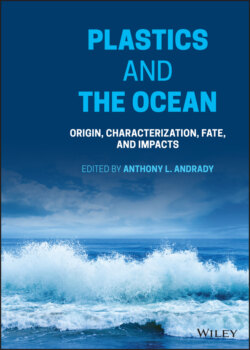Читать книгу Plastics and the Ocean - Группа авторов - Страница 40
2.2 Functional Additives 2.2.1 Plasticizers
ОглавлениеPlasticizers are added to plastics to improve their flexibility, durability, and elasticity over a broad range of temperatures while also reducing the glass transition temperature (T g) and the melt flow. The dissolved plasticizer molecules, not being covalently linked to the polymer backbone (Greco et al. 2010), can migrate freely within the resin matrix. The exact mechanism of plasticization is not fully understood; however, studies demonstrate that strong association of the polymer chains with the plasticizer molecules creates additional free volume in the bulk plastic matrix, yielding a softer and more flexible material (Greco et al. 2010; Ramos‐Devalle and Gilbert 1990).
Relatively high concentrations of plasticizers are required to achieve these desired changes in plastics, accounting for 34% of the total additives used in global plastics production from 2000 to 2014 (Geyer et al. 2017). Phthalic acid esters, or phthalates, are the most widely used plasticizers. Of the reported 8.4 million metric tons of plasticizers manufactured worldwide in 2017, about 65% were phthalate plasticizer used by the poly(vinyl chloride) (PVC) industry (IHS Markit 2018), with di(2‐ethylhexyl) phthalate (DEHP) being the most widely applied phthalates in PVC (Table 2.2). Because DEHP is highly regulated, it has gradually been replaced by diisononyl phthalate (DiNP), diisodecyl phthalate (DiDP), and di(2‐propylheptyl) phthalate (DPHP). In 2015, DPHP represented 57% of plasticizer consumption in Europe (ECPI 2016). However, the high loadings and migration of plasticizers from plastic materials have led to significant concern about the effects of phthalates in the marine environment as early as 1978 (Giam et al. 1978).
